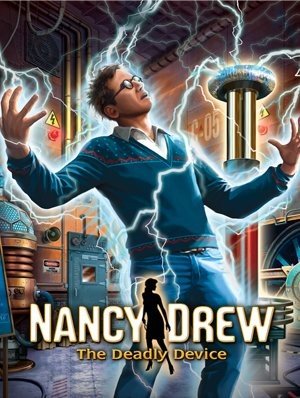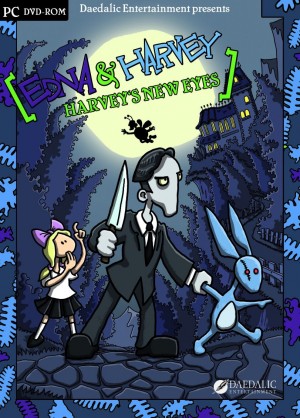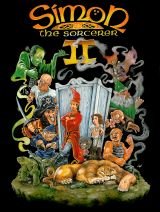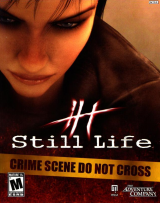Review for Nancy Drew: The Deadly Device
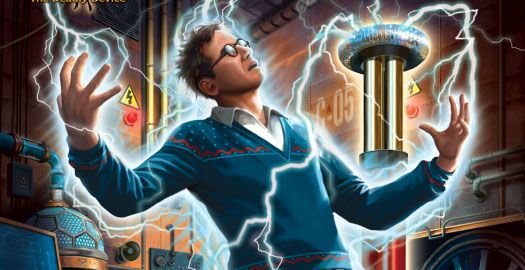
At times as crackling, though certainly not as deadly, as a live wire, Nancy Drew’s 27th detective outing, The Deadly Device, is an intriguing whodunit involving dueling inventors, dangerously malfunctioning lab equipment, and an office full of brilliant, if misanthropic, scientists. Her Interactive has juiced up its newest installment, and veteran fans and new players alike will find the abundance of well-integrated puzzles to be both challenging and fun, and will welcome the continuing, steady improvement in the series’ interface. And while the paucity of exploration in a largely mundane environment certainly limits its scope, the game’s focus on story will nevertheless keep you guessing until the very end.
The opening cinematic takes players through swirling snow to a strange looking lab filled with bizarre electrical equipment and an enormous Tesla coil, an alien-looking machine that emits high-voltage electricity. A scientist works alone in the room, when, without warning, the man is electrocuted to death. Niko Jovic was a brilliant scientist developing a revolutionary new technology: wireless energy. His death brings Nancy to a gray, imposing edifice at the behest of Victor Losset, who has worked with Niko for decades. Though it looks threatening, its sign reading "Technology of Tomorrow Today" promises all kinds of possibilities. Unfortunately for Nancy, because of the project’s sensitivity Victor wants her to work undercover, posing as a researcher for a potential investor.
As you begin your investigation, you’ll find the gathering of information slow going. This is a supremely technical laboratory, where you’ll be delving through the ins and outs of alternating and direct currents, Tesla coils, transistors, resistors, and diodes. You will be doing a lot of reading in this game just to get up to speed on all of the experiments the scientists are conducting. You’ll find books on the life and times of Nikola Tesla, the legendary battles between Edison and Tesla and their competing technologies, chemistry and biometrics (the study of fingerprint security), and more. In addition to reading, be prepared to do a lot of listening. Niko left behind a treasure trove of video diaries, but rather than being dull, the actor manages to communicate Niko’s increasing paranoia as he continues his experiments.
Thankfully, learning about electrochemistry and electronics isn’t all you’ll be doing. You’ll also interrogate the few souls left in the lab; no easy task, given this socially awkward bunch. The voice actors do a fine job of developing their characters, including Gray, a gruff and surly security guard with a secretive backstory. Niko’s motivations for recruiting him are murky, and he’s quite the misanthropist, yelling at one point to Nancy, “Nice work. Now get out.” If that isn’t friendly enough for you, his introduction to Nancy could also use a Miss Manners overhaul: “I’m Gray. I don’t care who you are. Now get out.” He’s not exactly one to help you out or speak too much. Another character/suspect is Ryan, the hyper-energetic young mechanic whose super-excited voice greets Nancy when she enters the tech workshop. A soft spot for gummy bears hasn’t stopped her from leaving threatening notes for Niko. Mason, a researcher working for Victor, takes the term condescending to nose-bleed heights. One person describes him as a computer with legs and a sweater – quite an accurate description, as he snidely describes his great contributions in his nasally voice. He’s meticulous to a fault, not to mention suspicious that Niko had been stealing from him. Mason’s colleague Ellie is cool and collected, except when it comes to Mason. She dislikes him so much, she can’t be in the same room with him, or so she says. And of course, there’s Victor: bombastic and loud and quick to anger, the man who brought you in to investigate but whom you’ll mostly be interacting with over the phone.
As you go through your dialogue choices, you’ll need to be careful not to make anyone too angry. Should you do so, the character will end their dialogue with you, and you’ll need to wait a bit before approaching them again. An additional trick to chatting with the characters is determining when you’ll encounter them. You’ll use an alarm clock to switch between nighttime and daytime investigations. Clicking on day or night always has you sitting through a short animation which you can’t skip. Given the number of times I switched between the two, it would have been nice to have a shortcut. You’ll also have to figure out how to get characters out of rooms at times, which may involve interacting with your environment or with other characters first.
Mirroring the mix of characters is the game’s mishmash art style. The swirling lines of Art Nouveau in Niko’s office (something that at first seems to clash with his dry, scientific mind) bump up against the jumbled mess of electronics in the lab, which sits just outside the smoothly modern glass circles hanging in the center of the complex’s atrium. The varied styles make you feel as if you’re getting a bit more exploration bang for your buck, given that you won’t actually be visiting very many rooms and don’t even have access to all of them at any one time.
There are some intriguing details in the art design. As you traipse through the building and day fades into night, the light streaming through the circular glass art installation slowly shifts. The lab researchers’ desks open a small window into their personalities: Mason’s desk is orderly – woe betide anyone who moves his lined-up paper clips or neat and tidy sticky notes. Ellie’s desk is filled with letters from friends at home; she has never felt comfortable in Colorado. The tech work room which Ryan calls home is filled with graffiti of a skull and bones and a big hog of a motorcycle. And it wouldn’t be a Nancy Drew game without those knowing winks from the designers, whether it’s the Krolmeister imprint on the technical equipment or a candy case chock full of Koko Kringles, Udder Pops (shudder), and Cudsmackers (chocolatey, chewy nougat treats).
These details help to improve the exploration quotient somewhat, but they don’t fully disguise the fact that you’ll never get out of the lab. That’s a grand total of two floors, which you traverse by using an elevator that goes through an animation every time you use it. This was an annoyance whenever I realized I was on the wrong floor and just wanted to skip directly to the room I needed to visit. The two floors contain dreary brown cubicles, a dark security room, Niko’s office, the student lounge, the tech work room, and the main laboratory and its offshoots. In comparison to some of Nancy's more exotic destinations, this one definitely feels more like work than a vacation.
With no change in navigation from previous installments, Deadly Device features a typical slideshow environment. There are very few ambient animations, though there are small animations when you interact with objects such as a mechanical bird that flaps its wings when you press a button or a robotic feline that sits and purrs when you pet it. The designers have made clever use of lighting and power outages to amp up the scares in the game, however. At one point when the lights went out suddenly, I gasped and felt anxious as I was forced to make my way through the room, stubbing Nancy’s toes along the way in near total darkness. These sudden attacks aren’t limited to just shutting off lights, either. At other times you’ll hear loud banging on your door in the middle of the night, frightening you from your sleep, or have to dodge flying shrapnel and heavy art pieces.
In between the deadly projectiles, you’ll be solving a variety of puzzles. Many of them involve finding information that particular characters would like to keep hidden from snoops and colleagues. You’ll also be collecting inventory, such as books with information that you’ll need to solve other puzzles, electronic components, and various notes and diaries. Some of the objects you gather go into an evidence bag in your inventory, but it doesn’t appear that you can do anything special with them; they merely serve keep everything that raises suspicion about various suspects in one place.
Some of the simpler logic minigames you’ll come across include anagrams and connect-the-wires puzzles. However, you’ll also need to solve more complicated challenges that involve learning binary code as well as paying attention to the chemical periodic table. You will learn how to create objects using 3D printing by viewing multiple views of the desired object in 2D, and must pay close attention to your surroundings; any scribbles on walls or notes could give you clues to obtaining such things as computer passwords. Sometimes the threat of a character catching you prying hangs over you as you solve these puzzles, which adds a good bit of tension to large portions of the game. And while the music is generally forgettable, the sound work adds delicious friction. The creaking and groaning of an elevator you’re riding about to give way really ramps up the anxiety. You’ll also hear characters talking just out of sight and the ominous sound of a shredder behind a closed door.
There are several timed puzzles, one of which involves solving it before the sabotaged brakes on the aforementioned elevator give out. The other requires making your way out of a maze of vents. I found that I had plenty of time to make my way out through trial and error, but even if you don’t or if you’re caught snooping and get kicked out of the lab, you always have the second chance option, which begins the puzzle over again. I always need to keep a notebook handy when playing Nancy Drew games, and this outing was no exception. I was constantly writing in and consulting mine as I took note of the chemical symbols for hydrofluoric acid, the order in which to turn electronic items on, and the various details of a larger puzzle that were sprinkled throughout the game.
As usual, you’ll get two difficulty levels to choose from: amateur and master sleuth. On the amateur level, you’ll get easier puzzles, a detailed task list, and a welcomed update: the addition of layered hints to your task list. Clueless about what to do next to accomplish a task? Click on a hint. These range from giving you the first stage of a multilevel puzzle to providing the solution outright, with a small amount of waiting time between each hint. While you can’t skip puzzles, you usually get a description or photo of the final solution. One of the exceptions is a Simon-type game where you have to play through and remember a long series of musical notes attached to colored buttons. Another exception is an arcade game called Aggregation. This is a Tetris-Bejeweled combination-type game, and you’ll need to play it to beat a character’s high score in order to move forward. Neither of these tasks proved too difficult on the easier level, fortunately.
This time around, Nancy's smartphone is used to chat with Victor as you progress in your investigation; your pals Frank and Joe Hardy, who can give you some tips as you talk through your discoveries with them; and a partner of necessity, the obnoxious yet helpful Diedre, an old acquaintance of Nancy’s. Feel like taking a break from all that snooping? You can also use your smartphone to play four completely optional minigames. You can receive text messages as well, which will bombard you with messages from a clearly lonely Ned, but will also give you necessary notes at critical junctures. As in previous games, you can use your phone to take photos, which can be especially helpful if you need to remember codes or clues you find along the way.
Codes, chemistry, electrodes, and silicon wafers may sound like the ingredients to a dreadfully dull game. And sure enough, like a slowly charging energy meter, the game takes a while to warm up as you get the lay of the electrical land in the Technology of Tomorrow Today. Yet over the course of nearly nine hours playing through The Deadly Device, I found myself being slowly drawn in to a story that went beyond a typical mystery outing. In fact, the game and its characters get downright philosophical about their work and the murder. What would you do if you were on the cusp of discovering a technology that would bring abundant energy to everyone? Would you sell it to the highest bidder? Would you give it to the world free of charge? It’s a shame there isn’t more to explore here, but with a well-told story that made it difficult for me to figure out the culprit and a wide variety of fun and engaging puzzles, that slow charge builds toward a dramatic and compelling finish.


